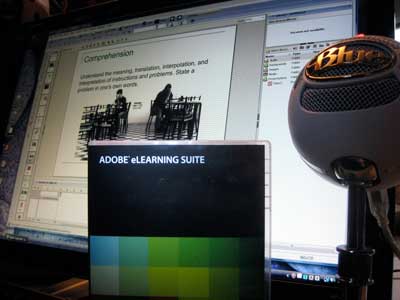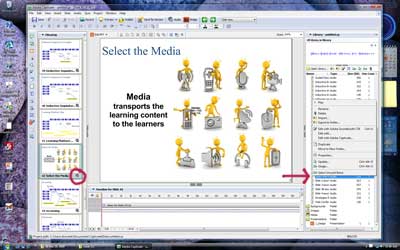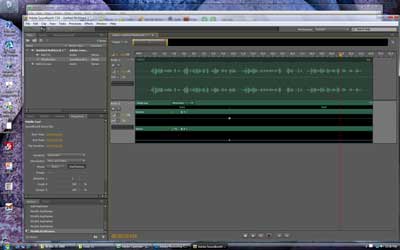
Adobe released a new elearning development platform a short while back for instructional designers and developers aptly titled eLearning Suite. It is a complete and tightly integrated solution for authoring rich learning content. Its complete in that it contains just about all the applications you need for building an engaging elearning platform and the applications are integrated in that they work well together, for example, when you update an asset (external file) in Captivate's Library, it is automatically updated in the Library, which provides a seamless workflow.
Probably the two main applications that most designers (I use the term designer to mean instructional designers, developers, and other learning specialists) will use for developing learning platforms are the new versions of Captivate and Dreamweaver. The new Captivate CS4 contains several new features, notably customizable widgets, project templates, and text-to-speech. It allows you to quickly create complete software demos or PowerPoint presentations with quizzes and multi-branching paths with different input sources.
Importing PowerPoint files has been greatly improved so that most features are now retained. It also includes a Table of Contents creator in addition to an aggregator that makes it easy to break content into small, reusable chunks.
The upgraded Dreamweaver CS4 contains an elearning application called Course Builder for creating elearning modules.
The suite also contains Adobe Presenter for rapid development of PowerPoint to elearning conversions if needed; however, I believe the majority of designers will prefer to use Captivate.
To help with the creation of content Adobe ELearning Suite also contains:
- Photoshop for working with graphic files such as JPG and GIF images.
- Flash for creating interactive content.
- Soundbooth for working with audio, such removing noise, adding a score to a narration and fixing the pitch and timings.
- Acrobat for exchanging documents, such as adding a rich text file to Dreamweaver project.
Rounding out the suite are:
- Adobe Bridge CS4, a media manager to organize, browse, locate, and view assets in a visual manner.
- Adobe Device Central CS4 that provides emulators for designing and viewing your content on more than 600 mobile devices, thus it is also an mlearning suite.
- A SCORM Package for creating LMS compliant content.
Using the eLearning Suite
The operating system I used is Windows Vista and runs on an Intel Pentium Dual CPU running at 2.0GHz and 6MB of memory. Even though I had several applications running at the same time, such as Captivate, Soundbooth, Photoshop, and MS Word, it ran the elearning suite with no problem. The only problem I encountered was when I first installed the suite and could not get the audio to work in Captivate CS4, but this was quickly solved.My main project was reworking a PowerPoint presentation.

Captivate CS4 allows you to easily manage assets through the Library in the right side panel (ensure you are in Edit mode). To locate an audio file in the library I clicked on it in the Filmstrip located in the left panel, which then highlights it in the Library. I right clicked it to bring up the context menu to select various options. I choose to edit it with Soundbooth, which quickly loaded with the correct file.

I cleaned up the audio by boosting the sound a bit and speeding it slightly up. When saved, it was automatically updated in the Captivate library. However, when I added a second track to an audio file in order to have some background music (score) play behind the narration, it changed the file's extension to a Soundbooth Score template (*.SBST), thus did not update in Captivate.
I tried saving it to an MP3 file to get a compact file but it only retained the narration and lost the music score (I'm not sure if I did something wrong or if this is just a limitation of the files. So I saved it to a WAV file, which was quite large, and then saved that as an MP3 file which worked quite well -- a small compact file plus it kept both tracks.
Then I tried the text to speech converter, but it reported that I did not have the files installed (I should have been given this option during the install process). So I pulled out the install discs and found it on disc 2/2 in the folder "English/Goodies/Adobe Captivate 4/Neospeech Text to Speech Voices/Captivate4-NeoSpeech.exe"
After running the Captivate4-Neospeech.exe to install, it worked fine -- enter some text into the slide notes panel, click "Text to Speech" on the slide note's bar, and then click the "Convert to speech" button. It brings up a dialog box asking if I want Kate or Paul's voice. I created two samples to preview (note that I did not use short, easy words but rather tried to put it to a real test):
I believe the text-to-speech feature would work fine on shorter passages in order to add different voices and effects, but I'm not so sure how they would play out in an entire elearning package. Also, I think they did a slightly better job on Paul's voice in that it sounds slightly more natural, how about you?

When I tried to do some branching with the slides I ran into some trouble, but a quick search led me to this post with video: Creating Branching Menus, which quickly answered my questions:
Next?
All-in-all the Adobe eLearning suite is a great product for designers, being that it is the first elearning suite, but what should Adobe do for the next version?First, while it does include Flash and Media Encoder CS4, it needs a much richer video editor, such as Adobe Premiere, since videos are now becoming a de facto standard for rich elearning platforms.
Secondly, while Photoshop is a great tool, the majority of designers will probably only use a few features of it, such as touching up photos and resizing them to fit the platform. So drop it and add Adobe Elements in its place that will fulfill most needs. Then add in Adobe Fireworks CS4 for prototyping and vector images as I see most designers getting a lot more use out of Fireworks plus Elements than the full version of Photoshop alone. For designers who really need Photoshop rather than Elements offer it in an extended version of the suite.
And finally, to keep the price about the same, drop Presenter as most designers will use Captivate. I see Presenter much more as a rapid development tool for SMEs. And since Presenter is wrapped up in the suite you cannot just give the SME that one tool out of the suite and let the designers have the rest. Rather, it should be offered as an add-on seat that can be purchased at a reduced cost after the eLearning Suite is purchased. This will allow organizations to purchase the correct quantity of eLearning suits for the designers and the correct quantity of Presenters for their SMEs, in addition to purchasing more as needed as the SMEs are not going to want to give it up once they have it :-) -- and of course hopefully they will continuing producing for informing and nonformal learning needs.
This will allow the SMEs to rapidly produce an elearning package and quickly get it out to those who need it in a just-in-time manner. If the elearning package is going to be in use for some time after that, the designers can then flesh it out into a better elearning platform using the full elearning suite. After all, this is what rapid development prototyping is all about -- get a bare minimum learning package out to learners as rapidly as possible so that they can become performers and then upgrade it as needed.
Dreamweaver
I'm trying the Course Builder in Dreamer. I will do a posting on it in the near future.More on Adobe eLearning Suite
Kushs' review of the Adobe eLearning Suite:
The eLearning Suite is priced at $1,799, with an upgrade price of $599. Captivate 4 is available alone for $799, or an educational price of $249. To learn more go to Adobe's web site, http://www.adobe.com/products/elearningsuite/.
5 comments:
Donald,
Very comprehensive overview of the Adobe eLearning Suite (eLS) and generally impressive article (it's too good to fit the moniker of 'blog post').
I know that it's probably early days for you implementing eLS, but I was wondering if you have had an opportunity to integrate the apps in the package with other e-learning authoring programs?
For example, as you discuss, the lack of a substantial digital video editor is a deficiency in the Suite: do you use a some other package (ie Premiere, Sony Vegas, Ulead VideoStudio, or one of the Avids) to generate video content for integration into eLS, and if so, how well did the tools align?
Thanks,
Michael
--
Hi Michael,
The apps in the suite work just as well with other programs as they are basically standalone apps. The only real difference between the suite and buying the apps separately is that you get a better price and some of them have extensions to them, such as Dreamweaver having the elearning Course Builder tacked on to it. In addition, when you pass a file off from Captivate to another application, such as Soundbooth, it automatically updates the file in Captivate's library -- of course this broke down when I changed the files' name when inserting another track and I had to manually update the file in Captivate.
Thus you can use just about any program to create/edit your videos and then import them into Captivate of Dreamweaver. For example, I had no trouble importing an AVI file that I edited with another program into Captivate.
The idea though would be to have a seamless integration where you could pass them off to Premiere for editing and it would automatically update the file in Captivate's library. Of course the integration needs to be tighter so if you changed the file's format (as I did in the Soundbooth example) it does not loose this integration.
Great overview. We recently posted about the specific new features in Flash CS4 at http://www.upsidelearning.com/blog/?p=523. Look forward to your comments on that.
I have only used Flash to a very limited degree in the past. One of my goals in the next few months is to increase my skills with it.
Yes, very nice review. Been looking all over for something that wasn't written by Adobe or those beholden to Adobe.
Post a Comment